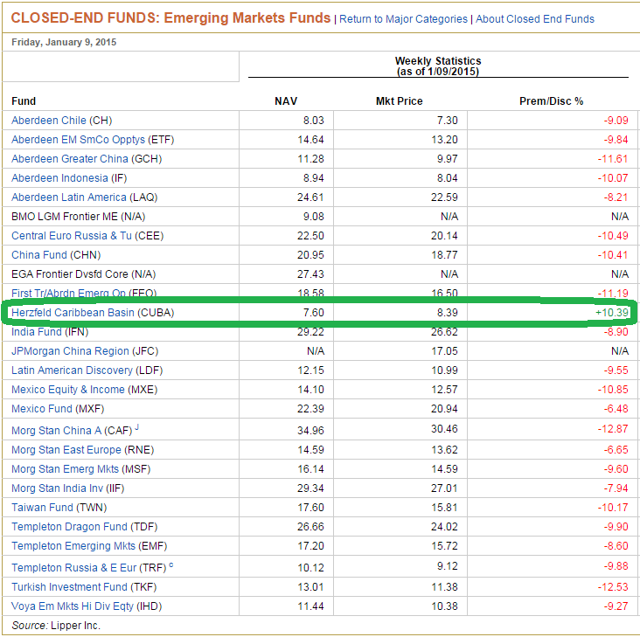Arbitraging 20% As An Exuberant Closed End Fund Returns To Normalcy Herzfeld Caribbean Basin Fund
Post on: 16 Март, 2015 No Comment

Summary
- ETFs and CEFs that track emerging market economies are often popular with foreign investors because they mitigate some risks of owning foreign equities such as accessibility, liquidity and local governance.
- However, emerging economies often have substantial risks that cannot be priced out by convenience, so these funds usually trade at a discount to their NAV.
- Occasionally, irrational exuberance will elevate an ETF or CEF above its NAV, creating an arbitrage opportunity.
- The CEF CUBA has been steadily returning to normalcy after a zealous run following President Obama’s Cuban Diplomacy announcement;
20% profit potential is still on the table.
Business As Usual
Exchange traded funds (ETFs) and closed end funds (CEFs) are convenient — one can buy a single asset and have a basket of exposure. ETFs and CEFs can be especially useful when they track foreign stock markets. They can mitigate a host of risk factors, such as accessibility to a foreign stock market, the liquidity of foreign equities, and local governance’s barriers to entry for foreign capital.
(Sourced from Google via Barclays )
While ETFs and CEFs can neatly catalog foreign equities into a convenient bundle, risks inherent to emerging markets remain. Currency woes, inflation battles, corruption — the list isn’t a short one. Therefore, it is rather common for ETFs and CEFs to trade at a discount to their net asset value (NAV). This is a combination of risk premium as well as management and expense fees.
Typically the spread between a fund’s NAV and its tick price — its discount/premium — is fairly constant. EM risk factors and management fees are generally sticky, so there isn’t much reason for the spread to fluctuate.
However, an exogenous event can distort the discount, even turning it into a premium. This creates potential arbitrage opportunities.
Business Is. Unusual
Three and a half weeks ago, President Obama ordered a return to full diplomatic relations with Cuba. While a significant departure from the decades old stalemate, significant hurdles remain. In particular, the 54-year-old trade embargo remains.
This highly unexpected event ignited an energetic rally in any equity with even loose ties to Cuba or the Caribbean. The Herzfeld Caribbean Basin Closed End Fund (NASDAQ:CUBA ) was one such beneficiary. At one point, it traded nearly 50% above its NAV.
Now that the political reality is beginning to sink in, CUBA’s premium has seen a steady reduction. However, it is still trading well above a rational value and the spread can be approximately arbitraged out, creating a nearly risk-free investment.
The Nuts And Bolts
Despite its suggestive ticker, the CUBA CEF is not relegated to Cuban assets (something that would be nearly impossible); in fact, it isn’t even meant to mimic the Cuban economy in particular. To quote from the fund management’s website :
The Herzfeld Caribbean Basin Fund’s investment objective is long-term capital appreciation. To achieve its objective, the Fund invests in issuers that are likely, in the Advisor’s view, to benefit from economic, political, structural and technological developments in the countries in the Caribbean Basin, which consist of Cuba, Jamaica, Trinidad and Tobago, the Bahamas, the Dominican Republic, Barbados, Aruba, Haiti, the Netherlands Antilles, the Commonwealth of Puerto Rico, Mexico, Honduras, Guatemala, Belize, Costa Rica, Panama, Colombia and Venezuela. The fund invests at least 80% of its total assets in a broad range of securities of issuers including U.S.-based companies that engage in substantial trade with, and derive substantial revenue from, operations in the Caribbean Basin Countries.
Since the fund’s investment scope has a loose mandate, let’s see what some of the actual assets are:














